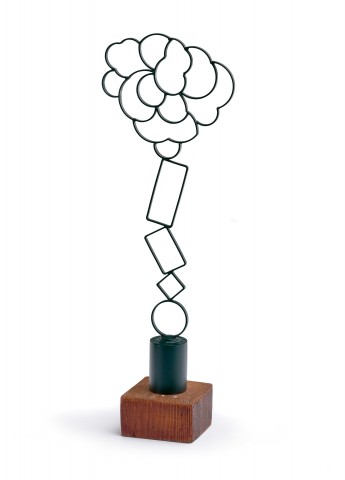NO. 266A, CYNTHIA, 1970
ROBERT KLIPPEL
brazed steel geometric sections and synthetic polymer paint on original wooden base
47.0 cm height (including base)
Mr and Mrs Les Wild, Sydney
Watters Gallery, Sydney
Private collection, Sydney
Estate of the above
Gleeson, J., Robert Klippel, Bay Books, Sydney, 1983, pl. 256, pp. 338, 339 (illus. another example as ‘Opus 266a’), 474
Edwards, D., Robert Klippel: Catalogue Raisonné of Sculpture, (CD ROM), Deborah Edwards and the Trustees of the Art Gallery of New South Wales, Sydney, 2002 (illus. CD–ROM Artworks, as ‘no. 266a’)
No. 266b (Cynthia), 1971, welded steel and paint, 253.0 cm height, private collection, formerly in The W. R. Burge Collection, Sydney
Between 1970 and 1971, Sydney sculptor Robert Klippel created a suite of small geometric constructions, each composed of slices of extruded steel pipe, their arrangements handsome in their simplicity and monumental in appearance. With serenity and delicate precision, the filigree geometric pattern of Klippel’s No. 266a teeters improbably on the vertical axis only to billow elegantly at its apex. With an intimate scale, this two-sided freestanding sculpture was first owned by Klippel’s collaborator, the metalsmith Les Wild. Proprietor of Electric Welders, in Rozelle, Wild was already working with the sculptor Tony Coleing to create large metal sculptures and was a pivotal presence in Klippel’s artistic journey at this time. Another small version of 266a, unpainted, was given to the artist’s wife, after whom it was named, while a large example of over 2m, fabricated by Wild, was later installed in the garden of Sydney collector, William Burge, a frequent visitor to the artist’s studio.
Completed in 1970, a few years after Klippel’s return to Australia from America, No. 266a belongs to a group of small geometric linear works far removed from the baroque and mechanical ‘junk’ sculptures that preceded them. The reduction in scale, use of a new visual vocabulary and different mode of fabrication of this group of sculptures was directly influenced by Klippel’s access to space, materials and his budding relationships with local Australian artists. In 1968, with his new wife, Cynthia Byrne, and their young son Andrew, Klippel purchased a large old house in the harbourside suburb of Birchgrove, hopeful to turn its boathouse into a home studio. Two short years later, with his marriage under pressure, Klippel resorted to purchasing a workshop on Liverpool St, Paddington on the advice of the artist Peter Powditch. 1 It was in this studio that Klippel created this entire suite, including the fourteen geometric constructions that were to be industrially fabricated on large-scale by Wild between 1971 - 1974, including No.266a.
Presenting a parsimonious counterpoint to the exuberance of previous constructions, Klippel’s small works employed a pared-back visual vocabulary, derived entirely from graduated geometric sections of steel piping. As his biographer James Gleeson noted, Klippel must have envisaged this aesthetic change some years before, having already amassed a large supply of materials and his first attempts in brazed steel demonstrating the confidence of resolved ideas. 2 The process of brazing joined the sections using molten metal, whose low melting point allowed it to fill gaps using capillary action. While, as an intimist, Klippel valued the authenticity of these minute traces of the artist’s hand in small works, this example 266a bears a painted grey-green finish closer in quality to Wild’s industrially perfected versions.
No. 266a demonstrates the whimsical assertiveness of a master sculptor, exercising his aesthetic judgment in a new format, a culmination of the refined linear and geometric themes that underpinning his earlier constructive works. Relying on intimate human scale and dynamic tension, the open lattice of No. 266a balances on a circular segment anchored on a solid cylindrical base. Confined to a single plane, the dynamism of this sculpture is created solely through the asymmetric relationships between the geometric building blocks. Klippel valued highly the ‘springiness and vitality’ of these small sculptures, their delicate equilibrium and traces of the artist’s hand, concerned that these qualities would disappear in larger copies.3
No 266a’s chain of unadulterated geometric shapes is improbably stacked, balancing meditatively like river stones, topped by a featherlight cloud of arced segments. Characterised by a curious combination of solemnity and lyrical whimsy, 266a is an elegant object quite unique in Klippel’s oeuvre.
1. Edwards, D., Robert Klippel, Art Gallery of New South Wales, Sydney, 2002, p.244
2. Gleeson, J., Robert Klippel, Bay Books, Sydney, 1983, p. 328
3. Artist’s notebook, 13 February 1973, cited in Gleeson, ibid, p. 330
LUCIE REEVES-SMITH
